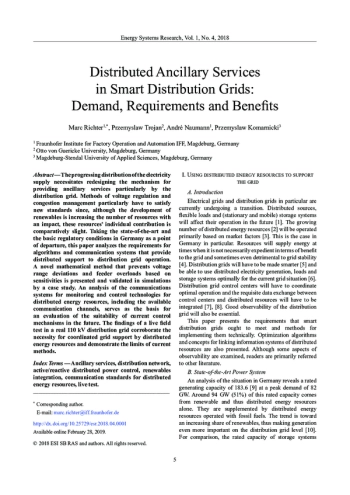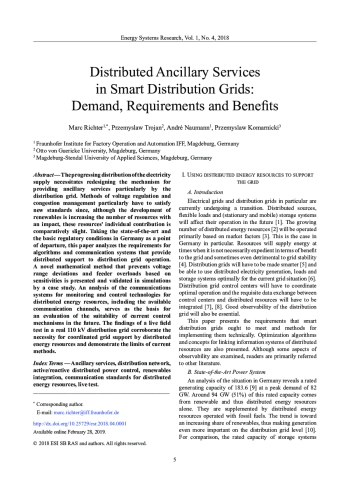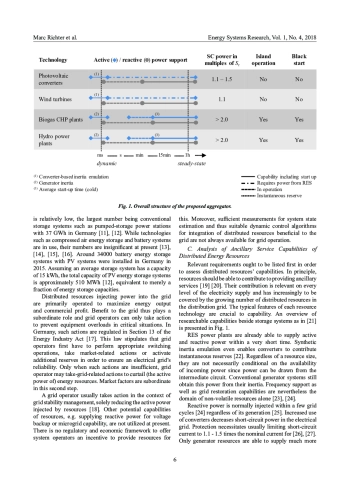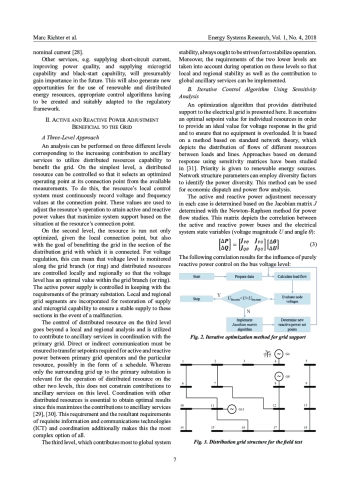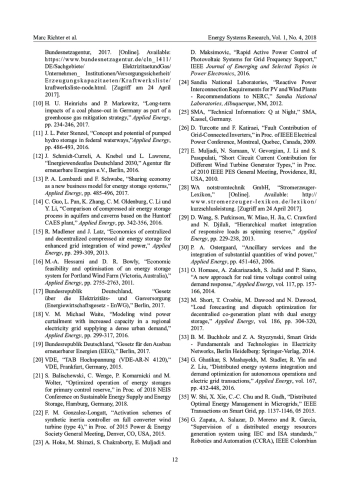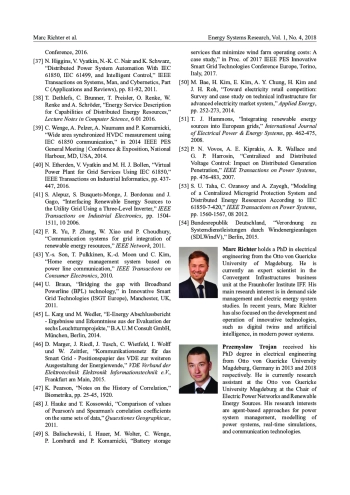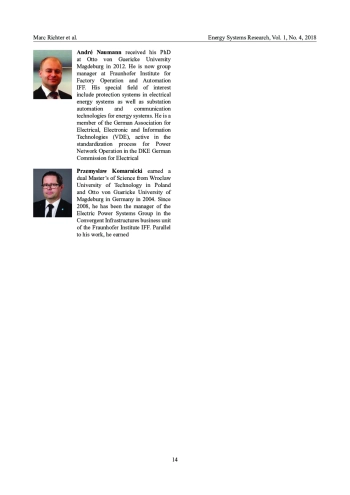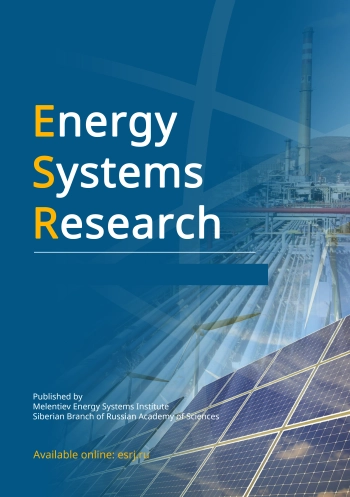The progressing distribution of the electricity supply necessitates redesigning the mechanism for providing ancillary services particularly by the distribution grid. Methods of voltage regulation and congestion management particularly have to satisfy new standards since, although the development of renewables is increasing the number of resources with an impact, these resources’ individual contribution is comparatively slight. Taking the state-of-the-art and the basic regulatory conditions in Germany as a point of departure, this paper analyzes the requirements for algorithms and communication systems that provide distributed support to distribution grid operation. A novel mathematical method that prevents voltage range deviations and feeder overloads based on sensitivities is presented and validated in simulations by a case study. An analysis of the communications systems for monitoring and control technologies for distributed energy resources, including the available communication channels, serves as the basis for an evaluation of the suitability of current control mechanisms in the future. The findings of a live field test in a real 110 kV distribution grid corroborate the necessity for coordinated grid support by distributed energy resources and demonstrate the limits of current methods.
Идентификаторы и классификаторы
Electrical grids and distribution grids in particular are currently undergoing a transition. Distributed sources, flexible loads and (stationary and mobile) storage systems will affect their operation in the future [1]. The growing number of distributed energy resources [2] will be operated primarily based on market factors [3]. This is the case in Germany in particular. Resources will supply energy at times when it is not necessarily expedient in terms of benefit to the grid and sometimes even detrimental to grid stability [4]. Distribution grids will have to be made smarter [5] and be able to use distributed electricity generation, loads and storage systems optimally for the current grid situation [6]. Distribution grid control centers will have to coordinate optimal operation and the requisite data exchange between control centers and distributed resources will have to be integrated [7], [8]. Good observability of the distribution grid will also be essential.
Список литературы
. J. Wang, “Smart grids, renewable energy integration, and climate change mitigation - Future electric energy systems”, Applied Energy, pp. 1-3, 2012.
2. J. Wu, “Integrated Energy Systems”, Applied Energy, pp. 155-157, 2016.
3. J. Winkler, M. Pudlik, M. Ragwitz and B. Pfluger, “The market value of renewable electricity - Which factors really matter?”, Applied Energy, pp. 464-481, 2016.
4. N. Ederer, “The market value and impact of offshore wind on the electricity spot market: Evidence from Germany”, Applied Energy, pp. 805-814, 2015.
5. N. I. Voropai and B. Bat-Undraal, “Multicriteria reconfiguration of distribution network with distributed generation”, Journal of Electrical and Computer Engineering, 2012.
6. C. F. Calvillo, A. Sanchez-Miralles and J. Villar, “Optimal planning and operation of aggregated distributed energy resources with market participation”, Applied Energy, pp. 340-357, 15 11 2016.
7. J. Yan, Y. Zhai, P. Wijayatunga, A. M. Mohamed and P. E. Campana, “Renewable energy integration with mini/micro-grids”, Applied Energy, pp. 241-244, 2017.
8. S. B. Myungchin Kim, “Decentralized control of a scalable photovoltaic (PV)-battery hybrid power systems”, Applied Energy, pp. 444-455, 2016.
9. Bundesnetzagentur, “Kraftwerksliste”, Bundesnetzagentur, 2017. [Online]. Available: https://www.bundesnetzagentur.de/cln_1411/DE/Sachgebiete/ ElektrizitaetundGas/Unternehmen_ Institutionen/Versorgungssicherheit/Erzeugungskapazitaeten/Kraftwerksliste/kraftwerksliste-node.html. [Zugriff am 24 April 2017].
10. H. U. Heinrichs and P. Markewitz, “Long-term impacts of a coal phase-out in Germany as part of a greenhouse gas mitigation strategy”, Applied Energy, pp. 234-246, 2017.
11. J. L. Peter Stenzel, “Concept and potential of pumped hydro storage in federal waterways”,Applied Energy, pp. 486-493, 2016.
12. J. Schmidt-Curreli, A. Knebel und L. Lawrenz, “Energiewendeatlas Deutschland 2030”, Agentur für erneuerbare Energien e.V., Berlin, 2016.
13. P. A. Lombardi and F. Schwabe, “Sharing economy as a new business model for energy storage systems”, Applied Energy, pp. 485-496, 2017.
14. C. Guo, L. Pan, K. Zhang, C. M. Oldenburg, C. Li und Y. Li, “Comparison of compressed air energy storage process in aquifers and caverns based on the Huntorf CAES plant”, Applied Energy, pp. 342-356, 2016.
15. R. Madlener and J. Latz, “Economics of centralized and decentralized compressed air energy storage for enhanced grid integration of wind power”, Applied Energy, pp. 299-309, 2013.
16. M.-A. Hessami and D. R. Bowly, “Economic feasibility and optimisation of an energy storage system for Portland Wind Farm (Victoria, Australia)”, Applied Energy, pp. 2755-2763, 2011.
17. Bundesrepublik Deutschland, “Gesetz über die Elektrizitäts- und Gasversorgung (Energiewirtschaftsgesetz - EnWG)”, Berlin, 2017.
18. V. M. Michael Waite, “Modeling wind power curtailment with increased capacity in a regional electricity grid supplying a dense urban demand”, Applied Energy, pp. 299-317, 2016.
19. Bundesrepublik Deutschland, “Gesetz für den Ausbau erneuerbarer Energien (EEG)”, Berlin, 2017.
20. VDE, “TAB Hochspannung (VDE-AR-N 4120)”, VDE, Frankfurt, Germany, 2015.
21. S. Balischewski, C. Wenge, P. Komarnicki and M. Wolter, “Optimized operation of energy storages for primary control reserve”, in Proc. of 2018 NEIS Conference on Sustainable Energy Supply and Energy Storage, Hamburg, Germany, 2018.
22. F. M. Gonzalez-Longatt, “Activation schemes of synthetic inertia controller on full converter wind turbine (type 4)”, in Proc. of 2015 Power & Energy Society General Meeting, Denver, CO, USA, 2015.
23. A. Hoke, M. Shirazi, S. Chakraborty, E. Muljadi and D. Maksimovic, “Rapid Active Power Control of Photovoltaic Systems for Grid Frequency Support”, IEEE Journal of Emerging and Selected Topics in Power Electronics, 2016.
24. Sandia National Laboratories, “Reactive Power Interconnection Requirements for PV and Wind Plants - Recommendations to NERC”, Sandia National Laboratories, Albuquerque, NM, 2012.
25. SMA, “Technical Information: Q at Night”, SMA, Kassel, Germany.
26. D. Turcotte and F. Katiraei, “Fault Contribution of Grid-Connected Inverters”, in Proc. of IEEE Electrical Power Conference, Montreal, Quebec, Canada, 2009.
27. E. Muljadi, N. Samaan, V. Gevorgian, J. Li and S. Pasupulati, “Short Circuit Current Contribution for Different Wind Turbine Generator Types”, in Proc. of 2010 IEEE PES General Meeting, Providence, RI, USA, 2010.
28. WA notstromtechnik GmbH, “Stromerzeuger-Lexikon”, [Online]. Available: http://www.stromerzeuger-lexikon.de/lexikon/kurzschlusleistung. [Zugriff am 24 April 2017].
29. D. Wang, S. Parkinson, W. Miao, H. Jia, C. Crawford and N. Djilali, “Hierarchical market integration of responsive loads as spinning reserve”, Applied Energy, pp. 229-238, 2013.
30. P. A. Ostergaard, “Ancillary services and the integration of substantial quantities of wind power”, Applied Energy, pp. 451-463, 2006.
31. O. Homaee, A. Zakariazadeh, S. Jadid and P. Siano, “A new approach for real time voltage control using demand response”, Applied Energy, vol. 117, pp. 157-166, 2014.
32. M. Short, T. Crosbie, M. Dawood and N. Dawood, “Load forecasting and dispatch optimization for decentralied co-generation plant with dual energy storage”, Applied Energy, vol. 186, pp. 304-320, 2017.
33. B. M. Buchholz and Z. A. Styczynski, Smart Grids - Fundamentals and Technologies in Electricity Networks, Berlin Heidelberg: Springer-Verlag, 2014.
34. G. Ghatikar, S. Mashayekh, M. Stadler, R. Yin and Z. Liu, “Distributed energy systems integration and demand optimization for autonomous operations and electric grid transactions”, Applied Energy, vol. 167, pp. 432-448, 2016.
35. W. Shi, X. Xie, C.-C. Chu and R. Gadh, “Distributed Optimal Energy Management in Microgrids”, IEEE Transactions on Smart Grid, pp. 1137-1146, 05 2015.
36. G. Zapata, A. Salazar, D. Moreno and R. Garcia, “Supervision of a distributed energy resources generation system using IEC and ISA standards”, Robotics and Automation (CCRA), IEEE Colombian Conference, 2016.
37. N. Higgins, V. Vyatkin, N.-K. C. Nair and K. Schwarz, “Distributed Power System Automation With IEC 61850, IEC 61499, and Intelligent Control”, IEEE Transactions on Systems, Man, and Cybernetics, Part C (Applications and Reviews), pp. 81-92, 2011.
38. T. Dethlefs, C. Brunner, T. Preisler, O. Renke, W. Renke and A. Schröder, “Energy Service Description for Capabilities of Distributed Energy Resources”, Lecture Notes in Computer Science, 6 01 2016.
39. C. Wenge, A. Pelzer, A. Naumann and P. Komarnicki, “Wide area synchronized HVDC measurement using IEC 61850 communication”, in 2014 IEEE PES General Meeting | Conference & Exposition, National Harbour, MD, USA, 2014.
40. N. Etherden, V. Vyatkin and M. H. J. Bollen, “Virtual Power Plant for Grid Services Using IEC 61850”, IEEE Transactions on Industrial Informatics, pp. 437-447, 2016.
41. S. Alepuz, S. Busquets-Monge, J. Bordonau and J. Gago, “Interfacing Renewable Energy Sources to the Utility Grid Using a Three-Level Inverter”, IEEE Transactions on Industrial Electronics, pp. 1504-1511, 10 2006.
42. F. R. Yu, P. Zhang, W. Xiao und P. Choudhury, “Communication systems for grid integration of renewable energy resources”, IEEE Network, 2011.
43. Y.-s. Son, T. Pulkkinen, K.-d. Moon und C. Kim, “Home energy management system based on power line communication”, IEEE Transactions on Consumer Electronics, 2010.
44. U. Braun, “Bridging the gap with Broadband Powerline (BPL) technology”, in Innovative Smart Grid Technologies (ISGT Europe), Manchester, UK, 2011.
45. L. Karg und M. Wedler, “E-Energy Abschlussbericht - Ergebnisse und Erkenntnisse aus der Evaluation der sechs Leuchtturmprojekte”, B.A.U.M Consult GmbH, München, Berlin, 2014.
46. D. Marger, J. Riedl, J. Tusch, C. Wietfeld, I. Wolff und W. Zeittler, “Kommunikationsnetz für das Smart Grid - Positionspapier des VDE zur weiteren Ausgestaltung der Energiewende”, VDE Verband der Elektrotechnik Elektronik Informationstechnik e.V., Frankfurt am Main, 2015.
47. K. Pearson, “Notes on the History of Correlation”, Biometrika, pp. 25-45, 1920.
48. J. Hauke and T. Kossowski, “Comparison of values of Pearson’s and Spearman’s correlation coefficients on the same sets of data”, Quaestiones Geographicae, 2011.
49. S. Balischewski, I. Hauer, M. Wolter, C. Wenge, P. Lombardi and P. Komarnicki, “Battery storage services that minimize wind farm operating costs: A case study”, in Proc. of 2017 IEEE PES Innovative Smart Grid Technologies Conference Europe, Torino, Italy, 2017.
50. M. Bae, H. Kim, E. Kim, A. Y. Chung, H. Kim and J. H. Roh, “Toward electricity retail competition: Survey and case study on technical infrastructure for advanced electricity market system”, Applied Energy, pp. 252-273, 2014.
51. T. J. Hammons, “Integrating renewable energy sources into European grids”, International Journal of Electrical Power & Energy Systems, pp. 462-475, 2008.
52. P. N. Vovos, A. E. Kiprakis, A. R. Wallace and G. P. Harrosin, “Centralized and Distributed Voltage Control: Impact on Distributed Generation Penetration”, IEEE Transactions on Power Systems, pp. 476-483, 2007.
53. S. U. Taha, C. Ozansoy and A. Zayegh, “Modeling of a Centralized Microgrid Protection System and Distributed Energy Resources According to IEC 61850-7-420”, IEEE Transactions on Power Systems, pp. 1560-1567, 08 2012.
54. Bundesrepublik Deutschland, “Verordnung zu Systemdienstleistungen durch Windenergieanlagen (SDLWindV)”, Berlin, 2015.
Выпуск
Другие статьи выпуска
An increase in service life of equipment and plants (objects) in electric power systems makes it more appropriate to relate the organization of a system of maintenance service and restoration of wear and tear to their technical condition. This, in turn generates the need to quantitatively estimate the indices of their individual reliability. There can be no data on failures and defects of concrete objects, therefore, in practice we often calculate generalized reliability indices. An intuitive understanding of the varied significance of varieties of attributes is reflected by classifying statistical data for some varieties of attributes. For example, they can be classified according to voltage class, design, service life, etc. At the same time, the question on the appropriateness of the statistical data classification is not considered. Initial assumptions of known methods and criteria of checking if it is expedient to classify the statistical data on failures of the electric power system objects in most cases are unacceptable, since they are not relevant to this data set. We have developed a new method and an algorithm to assess the appropriateness of the statistical data classification. Their novelty lies in the application of a fiducial approach to estimation of critical values of a sample from a set of multivariate statistical data.
The paper presents an option for determination of phase loads in the primary distribution network using the results of state estimation of the secondary distribution network that are obtained by smart meter measurements installed at the load and generator nodes. The problem of state estimation in the secondary distribution network based on measurements of the active and reactive nodal powers and voltage magnitudes rather than by the Newton method traditionally used for this purpose is solved by a method of simple iterations. Efficiency of using the proposed approach for determination of phase loads of the primary distribution network for each hour of daily curve of nodal powers is illustrated by the example of a 32-node test network.
The paper focuses on the probabilistic evaluation of oil and gas resources with the models and methods of AHP/ANP analysis. The AHP/ANP models are shown to be the particular cases of finite Markov chains, i. e. discrete random processes with Markov property. An integrated method (Markov expert logical analysis (МELA)) is proposed. The method is based on the models, methods and algorithms of Markov chains theory. This basis will stimulate the progress in research on multi-criteria decision-making problems that arise in various spheres. The paper presents different methods using MELA to allow for the uncertainty of numeric and nonnumeric data on gas reserves as methods of transformation of expert estimations into the probability distributions. Typical logical schemes are proposed for multi-criteria comparison of analogous objects, to take account of possible errors in porosity evaluation and to estimate project life.
The paper analyses the role of the Asia Pacific Region and East Asia, in particular, for both Russia and Mongolia as energy exporters. A quantitative assessment of coal, oil and natural gas markets demand of East Asia countries is made. The assessment relies on our outlook, and the outlooks of Russian and foreign organizations. The prospective directions of energy cooperation between Russia and Mongolia, which allow harnessing the resource, geographical and economic potential of the two countries and expanding energy cooperation with the other countries in East Asia, are proposed.
The paper places an emphasis on the fact that many publications on complex reliability assessment of electric power and fuel systems do not always substantiate the application of various methods. We address the “system”, “nodal”, and “estimation” approaches to assess the reliability of electric power systems, given reliable fuel supply to power plants. These approaches are accompanied by an analysis of their correspondence to the objectives and goals of the study, as well as an analysis of the validity of their application in terms of the obtained result accuracy, research time, complexity of search for and preparation of the input data and forms of their representation in a model. All the approaches were tested in case studies. The nodal and system approaches were tested on a conventional power system, while the estimation approach was tested on design diagrams of the gas and electric power systems of the Northwestern Federal District of the Russian Federation
The paper is concerned with the numerical simulation of the coal gasification process in an entrained flow of high-temperature air-steam mixture. Due to the high initial temperature and the process staging, it is possible to obtain an efficient gasification process. The study aims to examine the stationary conditions of staged gasification process by using a mathematical model based on one-dimensional heat and mass transfer equations with combined submodels to describe physicochemical transformations. The simulation makes it possible to determine the boundaries of the transition from the “single-stage” to the “two-stage” gasification conditions and identify the most promising ones.
The paper presents the background of creation and development of Mongolia’s electric power industry and its current state. Despite considerable energy resources, the country suffers from electric power shortage that is covered by electricity supplied from Russia and China. The expected considerable power consumption growth can be met by doubling generating capacities, enhancing electrical networks and by interconnecting the five existing electric power systems (EPSs) into an Integrated Power System (NPS) of Mongolia as a future component of the Northeast Asian Super Grid. To accomplish these tasks, we propose a number of conceptual structural and technological models for the development of Mongolian electric power systems that can form a basis for the future Integrated Power System of Mongolia.
Статистика статьи
Статистика просмотров за 2025 год.
Издательство
- Издательство
- ИСЭМ СО РАН
- Регион
- Россия, Иркутск
- Почтовый адрес
- 664033, Иркутская область, г. Иркутск, ул. Лермонтова, д. 130.
- Юр. адрес
- 664033, Иркутская область, г. Иркутск, ул. Лермонтова, д. 130.
- ФИО
- Стенников Валерий Алексеевич (Руководитель)
- E-mail адрес
- info@isem.irk.ru
- Контактный телефон
- +7 (395) 2500646
- Сайт
- https:/isem.irk.ru
